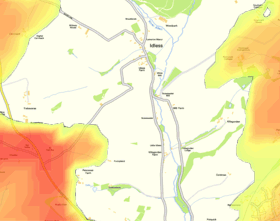 Southwest
Environmental Limited
Southwest
Environmental Limited Southwest
Environmental Limited
Southwest
Environmental Limited| London |
| 02076 920 670 |
| Exeter |
| 01392 927 961 |
| Manchester |
| 01612 970 026 |
| Bristol |
| 01173 270 092 |
A Visual and Landscape Impact Assessment is a collection of written and visual (images) information that attempts to explain and gauge impacts of a proposed development on visual amenity and the Landscape.
If you would like SWEL to prepare a report for you, deliver in PDF or HTML format we can do so. Please contact us for a fixed price quotation.
The European EIA directives and UK environmental regulations state that the impact of a development on the visual aspects of a landscape should be assessed. Guidance comes from the Landscape Institute amongst others.
The Landscape is
described as encompassing the following features:
-Natural Factors such as geological features,
land, air, soils, flora and fauna.
-Cultural / Social settles, enclosures, structures
-Aesthetic and Perceptual factors such as colour,
texture, sounds, and smells.
So is the area you are planning to build an areas which is visually
sensitive? A map has been published by the Countryside Commission and
English Nature called The Character of England Map.
 |
The Character of England Map for which we are
viewing the southwest quadrant can be visited
here. If we were to click on a segment we would be shown a list of the landscape characteristics; -Rolling, locally steeply-undulating open, pasture separated by many small valleys. -Heavy, poorly-drained soil supporting rushy pastures of low agricultural quality but high nature-conservation interest. -Wide views across a remote landscape. -Little tree cover except occasional wind-shaped hedgerow and farmstead trees, conifer blocks and valley woodlands. |
Reading of such characteristic can help envisage a development that might make use of the landscape in the area to minimise its visual impact.
Qualitative Visual Impact Assessment
| Visual Impact
Assessment is thought by many to be a very subjective discipline, using
modern 3D modeling it is possible to create scaled representations of
proposed developments, so we can look at impacts before they are built.
But in reality does this give a measured impact? Qualitative Visual Impact Assessment gives a good indication of negative impacts, but for large projects with far reaching implications a quantitative visual impact assessment is a better option. That being said under current legislative requirements a qualitative visual impact assessment is sufficient for planning applications. |
 |
Quantitative Visual Impact Assessment
|
Assessing Impact on a quantitative basis is accomplished using a ZTV (zone of theoretical visibility), and is present on a OS map base, zones on the map are presented as a % of the structure visible from that particular point. These factors and others will be assessed in the visual impact component of an environmental impact assessment. Please contact us if you have a need of visual impact assessments, or take a look at an example Visual Impact Assessment |
 |
The
assessment of
cumulative effects is
required by
the EIA Directive
(85/337/EEC, as
amended by
Directive 97/11/EC) and the
UK EIA Regulations 2011.
Cumulative effects are
defined as
resulting from
multiple actions
on receptors and
resources, as
a result
of impacts
from a single
project or
in combination
with other developments.
“additional changes to the landscape or visual amenity
caused by the proposed development
in conjunction with other
developments (associated with or
separate to it), or actions that occurred in the past, present or are likely to
occur in the foreseeable future”
As
per Section 5.0, it was noted that there was a great many pylons of
approximately 50 meters in height that run north south along high ground on both
sides of the Allen Valley.
There are numerous large livestock / grain storage sheds dispersed throughout
the assessed area, these buildings are typically 6 to 7 meters in height, with
some approaching 8 – 9 meters.
|
Visual Impact Assessment Rickmansworth Click the above link to read about a Visual Impact Assessment carried out for a multistory building in Rickmansworth, Hertfordshire. |
|
Visual Impact Assessment for Wind Turbine Click the above link to read about a Visual Impact Assessment carried out for Wind Turbine in Cornwall |